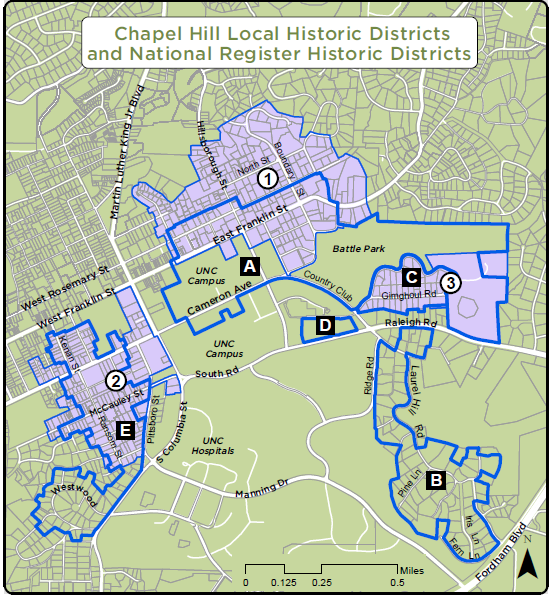As many readers will know, Chapel Hill Town Council recently approved the Housing Choices land use ordinance amendment in a 6-3 vote. The purpose of the amendment is to allow for more mixed housing to be developed in what are currently single-family-only zones.
This proposal brought out a full-scale panic in the community who have come to style themselves as the Save Chapel Hill movement. Their banner? Protecting Chapel Hill from… something apparently scary but peculiarly never truly defined. Their main weapon? Misinformation.
So when I, as a resident of the Franklin-Rosemary Historic District (previously described as the epicenter of the Save Chapel Hill movement), got a hand-delivered note in the mail inviting me to join my neighbors at a meeting to discuss “protecting our houses” by way of restrictive covenant, I considered it a civic duty to go along and report back.
I donned my (alas, metaphorical) fake glasses and mustache, and headed over to the Horace Williams House, which is also the headquarters for Preservation Chapel Hill, which advocates for the historic districts. Other than lowering the average age of the attendants by about 40 years, I thought I did rather a good job blending in. On my arrival, one neighbor said to me that he hoped I was “there to oppose this Putin-esque regime,” referring to the Housing Choices amendment to allow a few duplexes to be built across town. The meeting was well attended, with 30 or so property owners from the district in attendance.
The meeting took the form of being taught about restrictive covenants and their many purported benefits by a local attorney and historic district resident. In very basic terms, restrictive covenants are an agreement made between property owners that binds not only those folks, but all of their successive owners of that property.
Restrictive covenants have a sticky and unpleasant history in this country, with most restrictive covenants between the 1920s and the 1960s being set up for one purpose: to “restrict the Negro race” from being able to live in white neighborhoods. In full credit, the lawyer leading the meeting disclosed that information at the start of the meeting, and then hurriedly assured the attendees that, although that was what these had been used for in the past, that obviously wasn’t what we would be trying to do, oh no, far from it.
The plan, as the lawyer told us, was to bind all of the properties that they could muster together in a restrictive covenant, which would prevent, amongst other things, any dividing of the lot by any future owner, preventing a single-family lot from being used as anything other than that. The lawyer explained that, although one can’t guarantee this in perpetuity, the restrictive covenant document that was filed when the Tenney Circle properties were originally subdivided would help limit future changes. Essentially, the covenant would auto-renew every 20 years, unless 75 percent of the property owners gave their consent for it to be broken.
Let that sink in for a moment.
If a homeowner enters into this covenant, and then decides in three or four years that it was a horrible mistake, there is absolutely no way of escaping the covenant other than convincing 75 percent of the other homeowners who entered into that covenant that they should let you leave. And why would they? After all, in their words, they are “protecting the neighborhood.” It was made very clear that, should you attempt to break this covenant, you would swiftly be sued.
The lawyer opened up the floor to any comments and questions. Well, almost. At one point, a resident who lived in one of the few duplexes already in existence in the district asked whether this covenant would further any of the protections the neighborhood already enjoys by virtue of the Historic District Commission, and its powers to strike down any development which does not comport with the “character of the district.”
Having been begrudgingly advised by the lawyer that, no, this covenant would provide no greater protection than that which already existed, this neighbor started to speak passionately about how living in a duplex has given their children so many more opportunities to play with friends, and had brought so many people who wouldn’t be able to afford it otherwise into the district. It was at this point that the lawyer quite literally shouted this neighbor down, told them that this was not up for discussion, and indeed advised that if they continued they would be removed from the meeting.
At the end of the meeting, there was a general consensus amongst the homeowners that this was indeed the only way to go, and as far as this writer is aware, the plans to enact this covenant are full-steam ahead.
So, in some respects, the people behind Save Chapel Hill have accomplished their mission. None of their homes will be able to be torn down and redeveloped (unless they wait for the mandatory year-long delay in the historic district), they won’t have to have any more neighbors in their community (this wasn’t going to happen anyway), and they’ve successfully bound all of the future owners to this commitment, for ever and ever, Amen.

